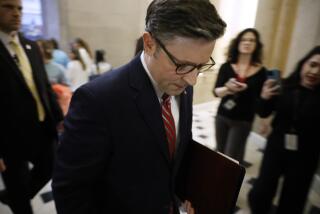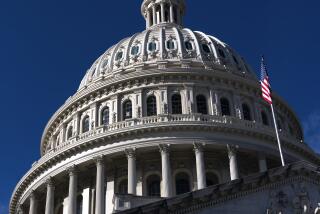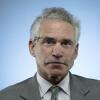A keep-the-bums-in mood may prevail in midterm election
After a highly contentious, hugely unproductive session, members of the most unpopular Congress in history will face voters this year and, very likely, win reelection in overwhelming numbers.
It is a paradox of these discontented times. Participants in a Cincinnati focus group led by Democratic pollster Peter Hart expressed their feelings toward lawmakers by drawing tombstones and broken hearts. Public opinion surveys show contempt for Congress reaching unprecedented levels.
But as much as they dislike their own representatives, Democrats and Republicans hold members of the opposite party in even lower regard.
“Republicans blame liberals and big government and Obama,” said Stuart Rothenberg, who analyzes races for his nonpartisan Rothenberg Political Report. “Democrats are upset because they think the tea party won’t allow anything to get done — Republicans are too extreme.”
That selective outrage works against the sort of throw-the-bums-out election that would produce wholesale, across-the-board upheaval in the House. After several elections that produced considerable turnover, including Republicans’ 63-seat gain in 2010, the likeliest outcome in 2014 is a comparatively modest partisan shift.
PHOTOS: 2013’s political moments
Democrats need to win 17 seats to regain control of the House, which they lost in 2010, the first midterm election under President Obama. That is not a huge number by historical standards but one that could prove insurmountable given the head winds Democrats face with the botched rollout of Obama’s signature healthcare program, his middling standing in polls and voters’ tendency, in off-year elections, to punish the party in the White House.
More significantly, there are far fewer takeover targets, since the number of competitive House seats has plummeted. Two decades ago, there were 99 crossover seats — that is, House districts that voted for one party for president and the other for Congress. Today there are 26, according to the nonpartisan Cook Political Report, which tracks elections nationwide.
Put another way, 93% of Republican House members represent districts carried by Republican Mitt Romney in 2012 and 96% of Democrats represent districts won by Democrat Obama, according to Cook. That partisan sorting leaves exceedingly few seats up for grabs.
That is not to say there won’t be at least a few fresh faces. California, once a lock for congressional incumbents, has more than half a dozen competitive congressional races — in San Diego, the Inland Empire and the Central Valley — thanks to new political boundaries drawn by a citizens’ commission rather than self-interested officeholders.
The chance for a partisan shift is much greater in the Senate, where candidates are forced to run statewide rather than hunkering in the partisan strongholds of the House.
Republicans, who need six seats to take control, start the new year with an advantage, at least on paper. Of 35 races, 21 are for Senate seats held by Democrats. All but a handful of the most competitive are in states carried by Romney, including Alaska, Arkansas, Louisiana, North Carolina, Montana and West Virginia. The latter two have open seats, as does Georgia, where Democrats are eyeing a rare pickup opportunity with Michelle Nunn, the daughter of retired four-term Sen. Sam Nunn.
The quality of candidate matters, as Republicans painfully learned in the last two election cycles when the party squandered opportunities to capture the Senate by fielding nominees seen as too extreme by voters in Nevada and Colorado, among other places.
This time, more than half a dozen candidates are running primary campaigns fueled by the tea party, running to the right of Republican Senate veterans including Thad Cochran of Mississippi, Lindsey Graham of South Carolina, John Cornyn of Texas and Senate GOP Leader Mitch McConnell of Kentucky. In Wyoming, three-term Republican Sen. Michael B. Enzi is battling Liz Cheney, daughter of former Vice President Dick Cheney, in a fiercely contested primary.
Frustrated by the negative impact of October’s government shutdown and the rise of a more confrontationally conservative breed of Republican, the GOP establishment has begun pushing back.
“We’re going to be getting involved in primaries earlier and more often than ever,” said Scott Reed, a political strategist for the U.S. Chamber of Commerce, which recently helped a favored Republican push past a tea party challenger in the race for an open House seat representing Alabama. “Our campaign effort won’t be about dropping a bunch of ads in late October, but rather a yearlong effort.”
Elsewhere around the country, several of the largest states will hold gubernatorial elections, including California, Florida, Illinois and New York. The outcome in some could help shape the 2016 presidential contest, now in its early stages. Republican Govs. Scott Walker of Wisconsin and John Kasich of Ohio face tough reelection fights but could emerge as White House contenders if they win second terms.
In Texas, where the Latino population is rapidly growing, Democrats hope their long-shot gubernatorial hopeful, Wendy Davis, can lead a demographic-driven shift from red to blue, or at least make the state a more competitive shade of purple by the next presidential contest in 2016.
Midterm elections tend to draw far less interest, and thus lower turnout, than contests held when the presidential candidates are also on the ballot. That tends to help Republicans, whose constituents are more likely to vote.
Some sort of crisis — economic, military, political — could change that; the fortunes of the two parties have already seesawed over the last several months.
For a time, anger over the government shutdown boosted Democratic prospects, raising hopes the party could buck the historic midterm pattern of losing congressional seats. But that advantage quickly evaporated with the problem-plagued launch of Obama’s healthcare overhaul.
“The lessons of both the last three months and the last several election cycles is that you shouldn’t make dramatic predictions,” said Roy Behr, a Democratic campaign strategist, who did allow as to how one thing seems certain to hold 11 months from now, when voters cast their ballots: “People will be unhappy with Washington.”
Unless something radical happens, that’s not likely to change much after the election either.
More to Read
Start your day right
Sign up for Essential California for news, features and recommendations from the L.A. Times and beyond in your inbox six days a week.
You may occasionally receive promotional content from the Los Angeles Times.







